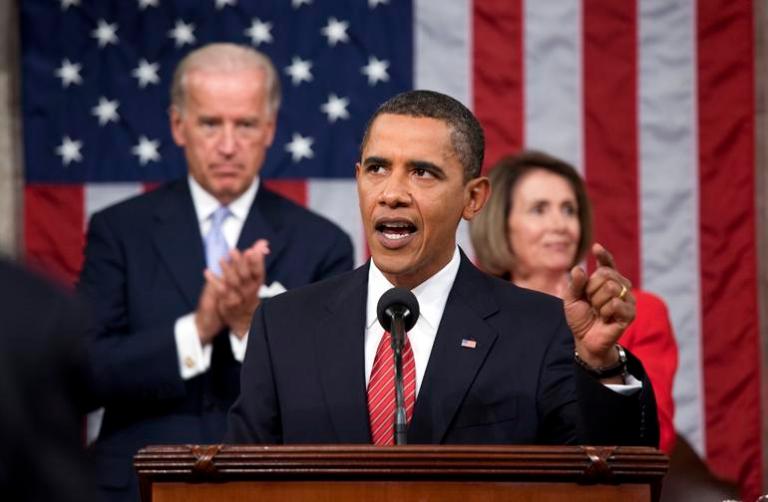 Here, kitty, kitty, kitty! While the Democrats hide, time to grow our own jobs program.Photo: Kevin Collins via Flickr[UPDATE at bottom of article.] I have a big, strapping cat who’s infamous for darting under a couch and cowering when a dog, even the tiniest, enters a room. Well, a yipping toy poodle has entered the Senate from the state of Massachusetts.
Here, kitty, kitty, kitty! While the Democrats hide, time to grow our own jobs program.Photo: Kevin Collins via Flickr[UPDATE at bottom of article.] I have a big, strapping cat who’s infamous for darting under a couch and cowering when a dog, even the tiniest, enters a room. Well, a yipping toy poodle has entered the Senate from the state of Massachusetts.
Never a bold bunch, the Democrats have gone into full-on retreat, spooked by the loss of Teddy Kennedy’s Senate seat. While the economy continues to unravel, Obama responds by declaring a freeze on “non-discretionary”–i.e., non-military–spending. That’s not a bold agenda for change; that’s panic.
People prone to being scared by deficit spending should keep in mind the concept of false economies. In the short term, it would make financial sense to spurn admission to Harvard and instead pursue a degree at your local community college. Long-term, it would be absurd. Like anything else, debt can be abused (think miliary adventures in Central Asia, or housing starts in deepest suburban Orlando). But it can also be used wisely.
While Obama caves in to the GOP, somewhere, John Maynard Keynes is having a stiff drink–and Herbert Hoover is stifling a chortle.
What the economy needs now is jobs, not fiscal austerity. And government spending, financed at low rates by Chinese investors, can provide those jobs. And it can do so in a way that jumpstarts the real, productive economy–as opposed to the house of cards Wall Street keeps cobbling together with its ever-stacked deck. Moreover, the productive economy we stimulate can be green and sustainable–and robust enough to repay investment many times over.
Here’s an example. In analyzing outcomes of the 2009 stimulus package, Smart Growth America found that “In the 10 months since the American Recovery and Reinvestment Act (ARRA) was signed, investing in public transportation produced twice as many jobs per dollar as investing in roads.”
To wit, a billion dollars dumped into maintaining our highway system, which enshrines the oil-guzzling car as our chief mode of getting around, generated 8,781 job-months. That same billion dollars used to build out mass transit created 16,419 job-months.
Investing in mass transit not only gives us an immediate pop in much-needed jobs–it also helps create the green, dense, liveable cities we’ll need in a carbon-constrained future. Propping up a crumbling highway system does neither.
So rather than bowing cravenly to know-nothing “fiscal hawks,” Obama should be making stirring speeches about the short-term jobs and long-term benefits of investing in mass transit.
But mass transit, as sorely needed as it is, is only one (albeit major) ingredient needed for green, liveable, productive cities. A robust food economy is another. In today’s cities, food is mainly a means through which wealth is extracted from neighborhoods. Even in the lowest-income areas, people spend at least $1,000 per capita on food every year. The great bulk of that cash leaks out of neighborhoods and into the coffers of distant entities like McDonald’s and Wal-Mart. The only thing left behind is low-wage, low-skill jobs–and health-ruining food.
Investing in local food economies can create other, more hopeful outcomes. Writing in Huffington Post, Michael Shuman brings the goods:
A study done two years ago found that a 20% shift of retail food spending in Detroit redirected to locally grown foods would create 5,000 jobs and increase local output by half a billion dollars. A similar shift to Detroit-grown food by those living in the five surrounding counties would create 35,000 jobs – far more than ever will come out of the multibillion-dollar bailout of the auto industry. The experience of microenterprise organizations around the country suggests that each of these jobs can be created for $2,000-3,000 of public money–a tiny fraction of the price of the last stimulus.
Shuman goes on to point to research from the Business Alliance for Living Local Economies (BALLE) showing how food enterprises can be engines for local economic growth.
The interesting thing about food, though, is that while it’s sorely in need of investment–and I made the case more than a year ago that the stimulus could and should have focused much more on it–food economies are buzzing and gaining force even as the broader job market withers.
Communities can and should agitate for more transit funding, but they can’t, say, install a light-rail system or put more buses on the road. They can, however, pool their resources and launch new, successful food enterprises. Just the other day, I read where people in Austin, Texas, are launching a community owned microbrewery. That excites me, and not just as a committed beer drinker who regularly visits Austin.
Imagine the potential here–skilled jobs in the brewery and in the kitchen, a new and potentially large market for locally grown barley and hops, and profits that circulate within the community and don’t skulk off to distant shareholders.
While the big Democratic cats in Washington cower under the couch, terrified of a 40-vote minority in the Senate, it’s going to be up to us that prove that real productive economies function much better than Geithnerian faith in Wall Street and its austerity agenda.
(Readers might also be interested in my piece from last spring on a similar theme: “Toward a more robust, and less efficient, food system.”)
[UPDATED to add:] If the Democrats do want to slink into the open and engage these critical issues, a great place to start would the upcoming 2010 (ne 2009) Child Nutrition Reauthorization Act, the five-year plan that governs spending for school lunches. Currently, we spend about $2.68 per student per day on school lunches–a miserly budget that (after labor and overhead) leaves less than a buck a day to spend on ingredients. In total, our annual allotment for school lunches amounts to a couple of weeks worth of mayhem in Iraq and Afghanistan. Investing more in school lunches–say, doubling the budget–and urging cafeterias to buy locally would be relatively cheap, stimulate local food economies, and quite likely improve kids’ eating habits and health prospects. Of course, we’d also need several years of multi-billion dollar investments in school kitchen infrastructure–but that, too, would generate short-term jobs and multiple long-term benefits.




